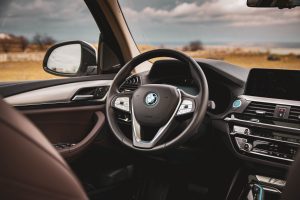The Numbers Show the World of Automotive Becoming Increasingly Digital
This year, 41% of recent shoppers plan to pre-order their next vehicle through a local dealer. Interestingly, of the 16% of recent online car buyers, 98% reported that they had a good experience and would do it again. The data supports that digital car buying is going to continue to be a trend as 38% of current car shoppers have reported that they intend to complete the entire car-buying process online without ever having to visit a dealership.
Why do these numbers matter? They matter because the data highlights the two things that today’s car buyer values most: convenience and customization. Leveraging innovative technologies in the automotive space can be a powerful way for automakers to capitalize on this trend and provide their customers with exactly what they are searching for while offering unforgettable experiences. Read on to discover five ways in which automakers can use technology to achieve this goal.
1. Utilize Virtual Showrooms to Give Customers a Sneak Peek Into Inventory
Through virtual showrooms, potential customers can view the dealership’s inventory or look at specific vehicles that meet the consumer’s needs. With vehicles becoming more expensive and harder to find, consumers want to be sure that their local dealership has the vehicle that they are interested in available in its inventory before choosing to physically visit the dealership.
Virtual showrooms can save your customers a considerable amount of time and energy, and that is exactly why more consumers make virtual showrooms their first stop in the car-buying experience nowadays.
2. Offer Augmented Reality Car-Viewing Capabilities
Taking virtual showrooms a step further, augmented reality can allow a consumer to see the interior of a particular vehicle so they can get an understanding of what it would feel like to sit inside the vehicle and drive it. Companies like Carmax and Carvana are already using AI features such as these to deliver customized experiences to their customers from the comfort of their own homes (or anywhere they happen to be at the moment).
This type of high-level convenience and customization is sure to delight your customers throughout their car-buying journey. The best part is that it can all be done from the customers’ smartphones.
3. Improve Vehicle Safety & Efficiency with Automotive AI
According to Speedir, AI used in automobiles has several incredible functions/benefits. Artificial Intelligence can improve a driver’s accuracy and safety through the use of collision warning alerts, automatic braking assistance, parking assistance, and other features. Features like these can reduce accidents and ultimately keep drivers and pedestrians safe. AI acts just like the human brain as it can recognize vision, speech, and facial movements through sensors, and make intelligent, calculated decisions on the driver’s behalf.
Coincidentally, Vice is reporting that car companies such as Cerence, Affectiva, Experi, and Eyeris plan to roll out emotion-detecting artificial intelligence systems for their cars in partnership with some of the world’s largest automakers by mid-2022. Their AI will contain features that will have the capability to pick up on such things as the driver feeling stressed, tired, or a wide range of other emotions that could hinder their ability to drive safely. The system will then alert the driver accordingly.
4. Improve Post-Purchase Vehicle Maintenance Through Artificial Intelligence Systems

Similarly, artificial intelligence can alert car owners of potential glitches well in advance before a major malfunction occurs, detecting changes in the car that signify failure even before it happens, for instance, concerning the battery and engine performance. This helps avoid costly damage and hinders safety risks in a timely manner.
Predictive maintenance offers several additional benefits such as:
- Reduction in depreciation rate
- Increase in the availability of safely-functioning vehicles
- Improvement in the overall efficiency of the car
Naturally, this will improve customer satisfaction and help boost the reputation of the particular automaker.
5. Connect Everything with the Internet of Things (IoT)
According to Oracle, in 2020, 91% of new cars sold in the US were IoT-connected. That’s more than 13 million connected vehicles sold in the United States alone. As the years continue to pass by, it’s almost impossible to think of driving a car that doesn’t link to your smartphone, stream your favorite playlist, or provide real-time traffic alerts to help make your overall driving experience more pleasant.
IoT allows automotive manufacturers to improve engineering and production to meet increasing demand. It also collects information about how a particular driver uses certain features and functions. This data enables manufacturers to modify, improve, or remove them from future designs so that their consumers will have the option to purchase cars that were truly built for them based on their individual preferences. Critical errors in the system can also be collected, which manufacturers can use to provide real-time support and updates to drivers.
Additionally, IoT can also be used to make roads safer through alerts that detect accidents and bad driving. There are currently more than 60 million vehicles in the United States that include automotive advanced driver assistance systems (ADAS), which include technologies such as adaptive cruise control, collision warning, and automatic emergency braking. These systems are designed to avoid collisions by alerting drivers to potential hazards or taking control of the vehicle to avoid any danger. IoT is what makes technology, such as ADAS possible.
Partner with Wizeline to Build a Strategic Technology Roadmap for Automotive
As you can see, technology is reshaping the world of automotive. Automakers and customers alike can benefit greatly from the use of technology across the entire lifecycle of a vehicle. By following the above five strategies of leveraging technology, automakers can feel confident that their customers will be delighted with their entire car-buying experience from beginning to end.
At Wizeline, our specialists in machine learning, cloud, data science, and other AI-centric innovations help clients in the automotive industry realize the power of these technologies. For example, we are helping a leading motorcycle manufacturer transform its mobile applications. We are also assisting a leading luxury car manufacturer to accelerate its product development.
Wizeline can be your company’s strategic partner in achieving its automotive digital transformation goals. To learn more about how Wizeline delivers customized, scalable data platforms and AI tools, download our guide to AI technologies and connect with us today at consulting@wizeline.com to start the conversation.







